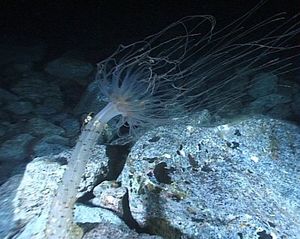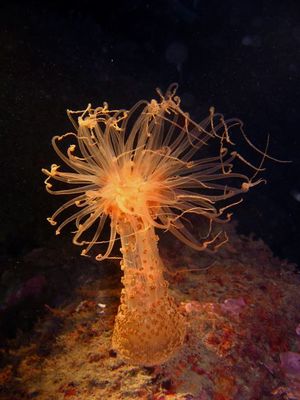|
Secrets of the Deep
BONUS EXTRAS |
Bioluminescence The mighty firefly - extreme close-up! Photo credit art farmer from evansville indiana, usa via wikipedia commons. The mighty firefly - extreme close-up! Photo credit art farmer from evansville indiana, usa via wikipedia commons. Alicia Mirabilis a.k.a. sea candles... Did you think we made them up? Nope, they're real! And they are, in fact, bioluminescent. Once again, Nature proves just as magical as imaginary things! Bioluminescence is the production and emission of light by a living organism. A firefly is the perfect example that we are all familiar with (pictured here in super-HD). You can click the image for an extreme close-up. Bioluminescence occurs in nature more often than you might think. Examples can be found in marine vertebrates and invertebrates, some fungi, and scores of microorganisms including bacteria and terrestrial invertebrates. Alicia Mirabilis Alicia mirabilis. Photo credit CC BY-SA 3.0 via wikipedia commons. Alicia mirabilis. Photo credit CC BY-SA 3.0 via wikipedia commons. Alicia mirabilis is a type of sea anemone found in such countries as Azores, Portugal, Spain and such seas as the Mediterranean and Red Seas. Divers will go out in tour groups at night to view them underwater. As night falls, this amazing sea anemone changes shape, expanding its body and tentacles to catch food. It's main body can reach up to 16 inches long and its sweeping tentacles can extend out from its body another 3 feet. Here's the one small catch where our fiction departs from marine biology: Small berrylike protrusions all along the body, and also embedded in the tentacles, contain a neurotoxin! An unassuming trap, these cells contain a poisonous harpoon type needle that when brushed across by a prey, fires, injecting the toxic chemicals into the unsuspecting little fishy, quickly causing paralysis and death. At least if you're a fish. Now, the poison is not strong enough to kill humans (or mermaids for that matter), but it can cause pain, sort of like being stung by a jellyfish. So, in reality, although Sapphira might be tempted to pry one of these little guys off a rock to light her way, it probably wouldn't be wise. We felt a little bit of artistic license here could be granted. :) Finally, here's a brief video of alicia mirabilis in its natural environment...
2 Comments
6/9/2021 12:40:54 am
Wow, I've never thought about it in my life, and I've never seen these views. Thank you to the author for the useful information and cool images
Reply
Leave a Reply. |
|
© E.G. Foley 2023
|


